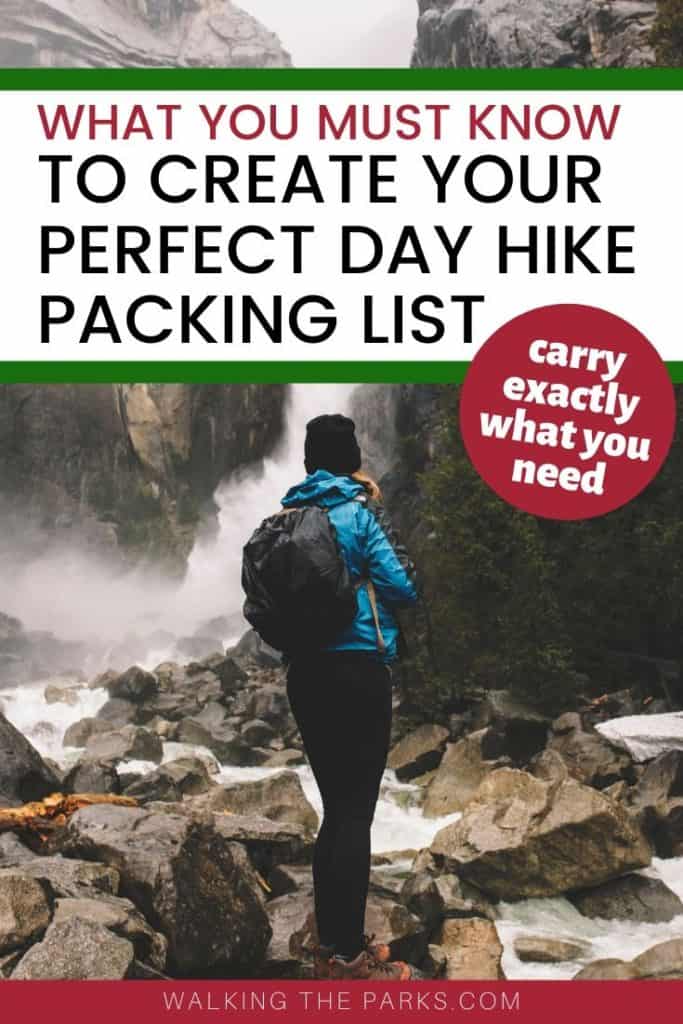Here’s a complete list of what to pack for a day hike. Let’s walk through the essentials for every type of hiking weather and trail so you can hike knowing you have exactly what you need.
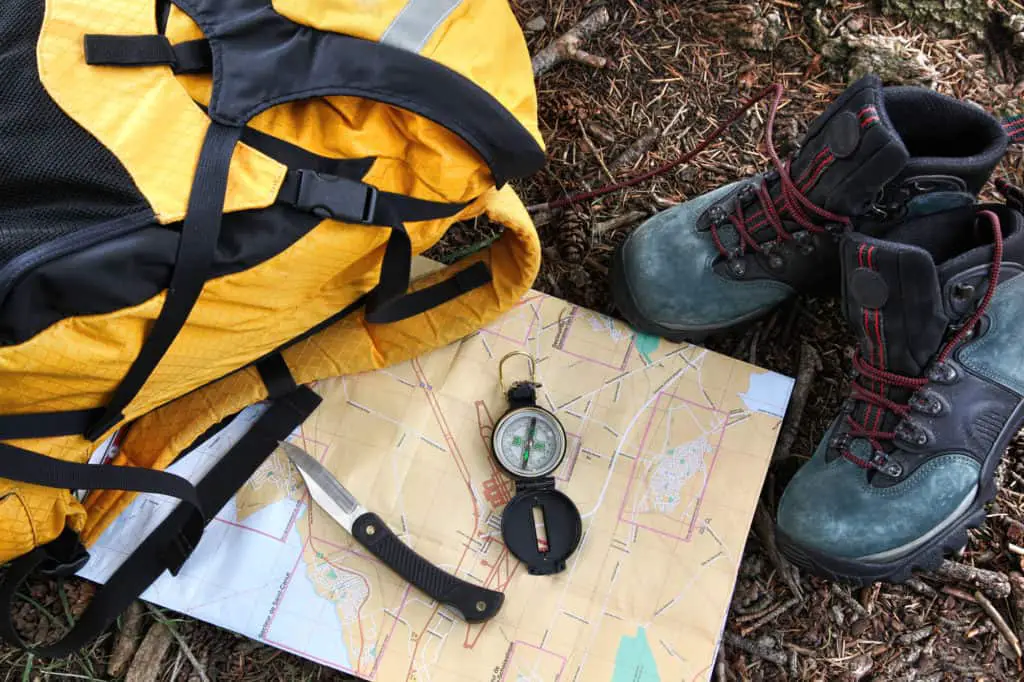
Are you feeling a little overwhelmed when deciding what to pack for a day hike? First, one article says to carry next to nothing when you backpack because minimalism is the way to go. Then the next article you read has ninety-nine items on the list and tells you that you will die if you don’t pack everything.
So how do you decide what to bring when hiking?
The truth is that the best day hiking packing list is different for each person, for each type of hike, and for various weather conditions. So we are going to help you create your own personal packing list. Below, we walk through every item that you “might” need on a day hike and review when and why you would need that item. Some, like water, are non-negotiable. Others, like rain pants, you can skip on a day hike in the desert in July.
Always Carry the 10 Hiking Essentials in Your Backpack
You’ll hear a lot about the 10 essentials in hiking gear. The essentials are categories of gear that every backpack should include. These are basic hiking gear categories that you need to pack for every hike, no matter how long or short.
Here are the categories of essential hiking gear. Pop down below, and we will go into detail about what you need for different levels of hiking with examples of gear that work well for day hikes. This will help you plan for hiking what to pack.
Table of Content: 10 Essentials for your Hike
- Hydration: Water and More
- Energy Replenishing Meals and Snacks
- Extra Clothing Layers for Weather Changes
- Appropriate Footwear for Comfortable Feet
- Sun Protection
- Safety and Comfort Gear
- Basic Survival Tools
- Navigation Tools Everyone Needs
- Emergency Overnight Kit
- First Aid Kit
We will dive into these items that should be on your day hike packing list so you know precisely why you need that item and how to pick the best day hiking essentials to pack.
One more note, throughout this article, I’ve linked to some of our more in-depth articles about how to select lightweight and compact gear for hiking. In other cases, you’ll find direct affiliate links to make it easier to find the products I mentioned, and in some cases, we could earn a small commission.

Looking for gift ideas for your favorite Hiker? Check out our Unique Guides!
Day Hike Essentials Start With The Best Daypack
Before you even start packing, take a look at your hiking backpack. If you are heading out for more than a couple of hours, good quality and well-fitted day pack is the difference between a relaxing evening and your back all tied up in knots. Believe me. I’ve been there. I hiked with an old-school backpack for a couple of years and was shocked at the difference when I finally changed to a quality daypack. You can read all about how to select the perfect daypack here.
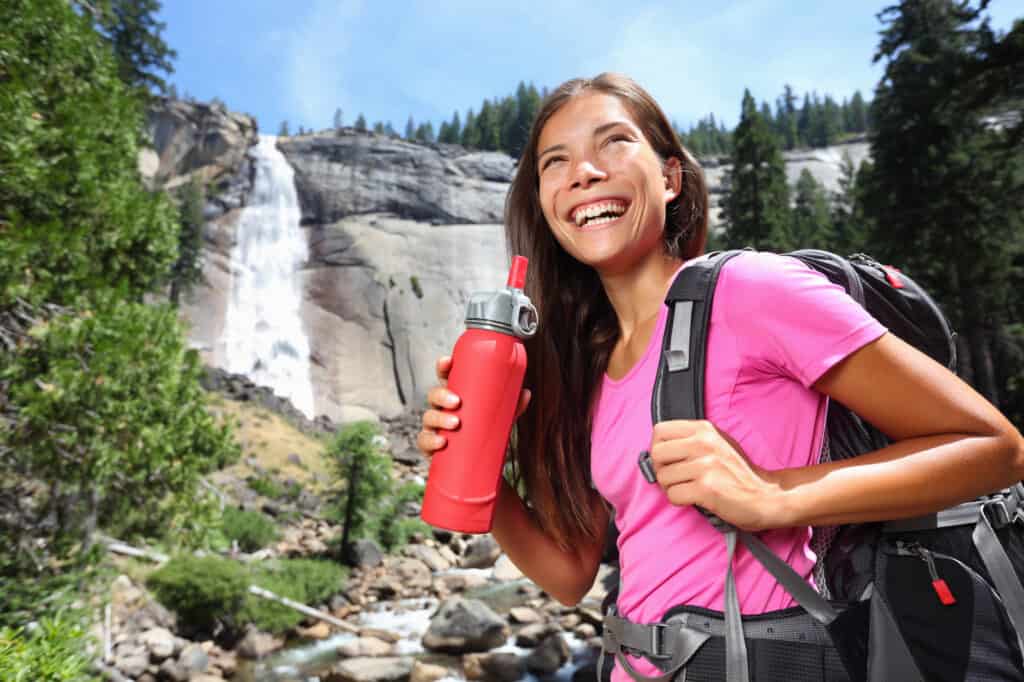
#1 Hydration is Critical in Your Day Hike Packing List
When planning for hiking and what to pack, plenty of water is the most important thing to pack for a day hike. Dehydration is dangerous. You can easily become disoriented, and experience muscle cramps or seizures, all of which can leave you in a life-threatening situation when far from help.
✔️ How Much Water Should You Carry?
How much water should you carry? The general advice is ½ liter per hour of day hiking. So figure that’s for an average person on an average trail on an average day. Are you average? Probably not, so adjust for factors like the weather, access to fresh water on the trail, and the strenuous level of your trail.
Should you carry water bottles or use a water bladder? It doesn’t matter. We usually carry both for a full-day hike. We recommend for most day hikes, you should start with a 3-liter water bladder. Then throw in additional water bottles depending upon the trail condition and the weather. Collapsible water bottles like these refillable water bottles that weigh less than 2 ounces will save a lot of space in your pack.
✔️ Pack a Lightweight Backup Water Purifier
For a single-day hike, your water purifier is only a backup in case conditions are worse than you expected, and you run out of water. A Life Straw water filter is a perfectly simple and lightweight solution. Brad ran out of water on a strenuous hike (see his story about hiking to Medicine Grizzly Lake). It’s not a good place to be. You should look to more serious solutions for longer hikes where filtering is your primary water source.
✔️ Electrolyte Drink Mix for Hot Weather
When it’s hot, your body might lose water faster than you can replenish when you are hiking. At that time, adding a packet of electrolyte drink mix to your water will help reduce the symptoms of dehydration. Just pack one or two of those single-serving packets in that emergency kit zip lock bag you carry in your backpack.
#2 Pack High Energy and Nutritious Food To Fuel Your Adventure
You will burn 400 to 500 calories per hour when hiking, so when planning what to bring when hiking remember you’ll need more food than you normally eat in a day to fuel your body.
✔️ Nutritious and Delicious Lunch
We take great joy when day hiking making lunch a special experience. Lunch starts with finding a fantastic view and then opening up a delicious meal. Here’s a list of Day Hike Lunch Ideas if you want suggestions.
✔️ High Energy Snacks
And don’t forget to add to your day hiking packing list a variety of high protein and high energy snacks like dried fruit, nuts, and snack bars. We also like to carry protein snacks like FireCreek Snack Sticks, peanut butter and cheeses. All of these are lightweight and pack well. And, just like water, carry more food than you think you need to prepare for any emergency.
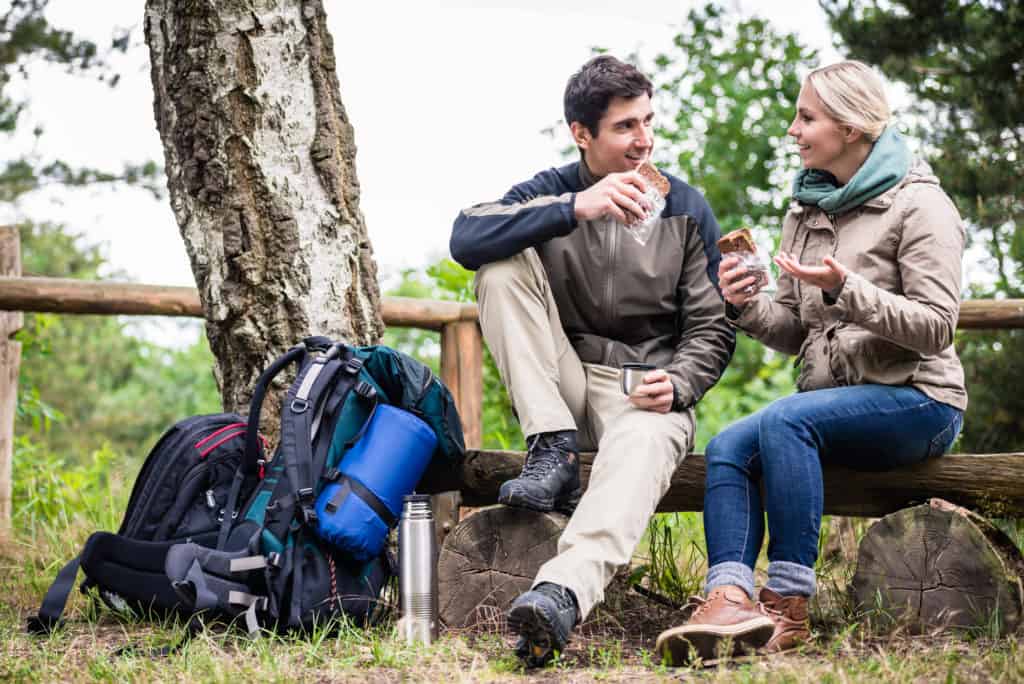
✔️ Don’t Forget a Garbage Bag
Pack out all your garbage. Even apple cores need to be packed out so they don’t attract animals to the trail. Those cute little critters are safest when they forage for their food. And, of course, the golden rule of don’t be a litterbug always applies on the trail.
#3 Pack Clothing Layers to Adjust to Weather Changes
Most day hikes include a variety of weather changes during the day. It might start cool in the morning and be sweltering hot by mid-afternoon. Or in the mountains, it rains most afternoons. By planning what to pack for a day hike with layers in mind, you can stay comfortable in all types of weather.
✔️ Rain Jacket
A lightweight rain jacket should always be in your pack, regardless of the forecast. It’s a sure thing that you will experience unexpected rain more often than not. Not only is it uncomfortable to hike soaking wet, but a wet body is also much more likely to experience hypothermia.
You’ll also appreciate the rain jacket as a protective top layer if it becomes windy while hiking.
✔️ Rain Pants
Many hikers make the mistake of skipping rain paints, thinking their quick-drying hiking pants will take care of them. Sure, that’s true if you get a light rain and then it clears up to a sunny day. But just as often, you get stuck in the pouring rain and then dropping temps. A lightweight pair of rain pants over your shorts will save the day.
✔️ Fleece or Warm Middle Layer
Even when hiking in the desert, temperatures will drop as evening sets in, and you’ll be glad to have a warming layer. Brad and I like to pack a Columbia fleece jacket for most hiking because they also make an excellent mid-layer under a rain jacket. We are OK with the bulk of fleece because it is so lightweight. I’ve also used it as a pillow when resting on the trail.
During our Alaska hiking trip, I used a waterproof puffer jacket for my middle layer expecting cold days. You’ll love that it’s so easy to scrunch up in a little bag in your daypack.
Personal Comfort also extends to what you wear on the trail. Check out these articles:
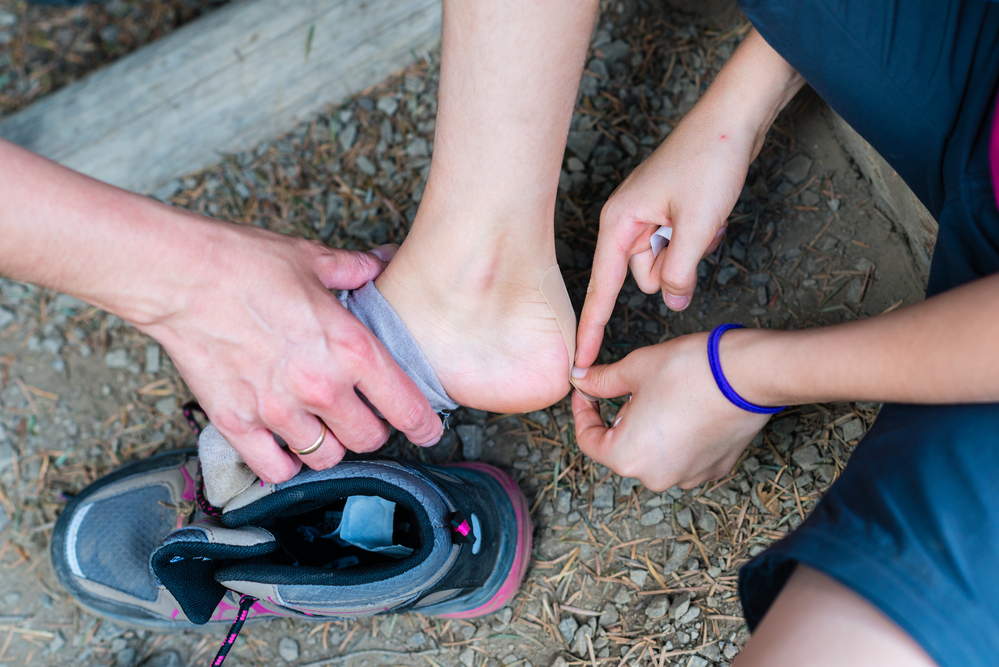
#4 Footwear to Protect Your Feet
Obviously, you already have your favorite pair of hiking boots or shoes on your feet, ready to hit the trail. Here are a few more items you should pack when day hiking to avoid foot pain at the end of the day.
✔️ Extra Pair of Socks
It sucks to hike all afternoon with wet socks in your hiking boots. Talk about blister city! Your socks can easily get wet from your feet sweating in your boots to an unexpected downpour to a stream crossing. So toss in your best hiking socks, and your feet will thank you!
✔️ Blister Care
Although this is a basic in most first aid kits, it deserves a separate call out. Nothing will ruin a hike more than the heal of your shoe rubbing a new blister to life. You’ll find it well worth it to invest in blister protection bandages. And in a pinch, a piece of duct tape over a budding blister will give you temporary relief.
✔️ Water Sandals – Optional
Let’s put these on the optional packing list for day hiking since they take up significant space. Occasionally you just know in advance that your hike will require fording a lot of streams. Sometimes the creek is the trail. Then, by all means, tuck a pair of good hiking waterproof sandals that strap on tight into your pack.
Note, don’t bother with flip-flops; they will rip off your feet in the first current.
#5 Don’t Forget Sun Protection on your Day Hiking Packing List
✔️ Hat
The sun can get pretty intense at higher elevations or in the Southwest. You need a hat for sun protection. I like a hat that I can wad up in my bag that also serves as a rain hat. Brad prefers a ball cap type. Go with what makes you most comfortable. Please add a sun hat to your day hike packing list and protect yourself.
✔️ Sun Screen
Hiking essentials include an environmentally friendly sunscreen. You never know when you will hop in a lake to cool off. You don’t want to leave chemicals behind in that pristine lake water.
I fell in love with Alba Botanicals when we were rafting because it feels clean when you are sweating, so now I use it for extra sun protection when hiking too.

✔️ Sun Glasses
Throw an extra pair in your pack. Imagine leaning over a cliff edge for a better view with your sunglasses sitting atop your head and then watching your sunglasses go tumbling down. Yeah… it’s happened a time or two. Or add a sunglass lanyard to keep them snug on your head.
✔️ Chapstick SPF
You’ll be getting quite a workout hiking which means a lot of water loss. It seems the lips are always the first place to dry out.
✔️ SPF/UPF Shirt
Include in your backpack a long sleeve sun protection shirt that will stop cancer-causing sun rays from penetrating. If the trail is sunny, you’ll love one of these shirts. If you get one in white, it will reflect the sun and help keep you cool simultaneously.
#6 Safety and Comfort Gear
✔️ Trekking Poles
A definite requirement for me. You’ll find lightweight trekking poles that reduce the wear and tear on your knees on uneven terrain or steep hikes. Now Brad only takes them if we are on a very strenuous hike. Trekking Poles are inexpensive, so don’t be afraid to try them out to see if they increase your trail comfort level.
✔️ Bio Gear
That means toilet paper, a baggie or trowel and hand sanitizer. When they say “pack it out,” they mean everything. In some parks, it’s acceptable to bury your waste. In most, you need to carry it back out with you. Busier hiking trails might have a rustic toilet at the trailhead, most often without any toilet paper. So, add a few sheets of toilet paper in a zip lock bag to your essential gear, and you’ll be ready for a quick and not too gross clean-up if needed.
Oh, and one of those mini bottles of hand sanitizer will make you feel a lot better about the whole thing. If you are really brave, you might try a women’s urination device that lets ladies do it standing up.
✔️ Bear Spray
If you are in Grizzly country, your day hiking essentials must include Bear Repellent Spray. Yes, it’s around $30 that you may never use. But if you do ever need bear spray, you’ll be glad you have it. In some National Parks, like Glacier, you can rent a canister for the day.
✔️ Backpack Rain Cover
A high-quality rain cover for your hiking backpack will keep all your essential gear dry when day hiking in the rain, planned or unplanned 😊. These hiking essentials pack into a small space and are ready to use if the weather surprises you. You’ll be glad to have a cover along.
#7 Basic Survival Tools
✔️ Knife or Multitool
As every scout knows, you must have a good multi-function pocket knife. Or even better, pack a multitool designed for hiking with a bit of everything you need. It seems that there’s always a tool you need, and it’s right there.
✔️ Flashlight or Headlamp
We are so guilty of lingering on a trail a little too long and getting back as the sun sets. For that reason, we usually pack an extra between our bags. Having a working headlamp or quality waterproof flashlight is so important on the trail. We took a deep look at some of the Best Ultralight Headlamps for Hiking in this article.
✔️ Duct Tape
What is there to say about the ultimate lightweight repair kit? Wrap a couple of loops around your trekking poles, which will always be handy. Great for quick repair of a torn bag, a broken shoe or even blister relief.
✔️ Whistle
Perfect for getting attention if you are injured. Or if a bear is wandering around. Hook your whistle to one of your zippers for easy access.
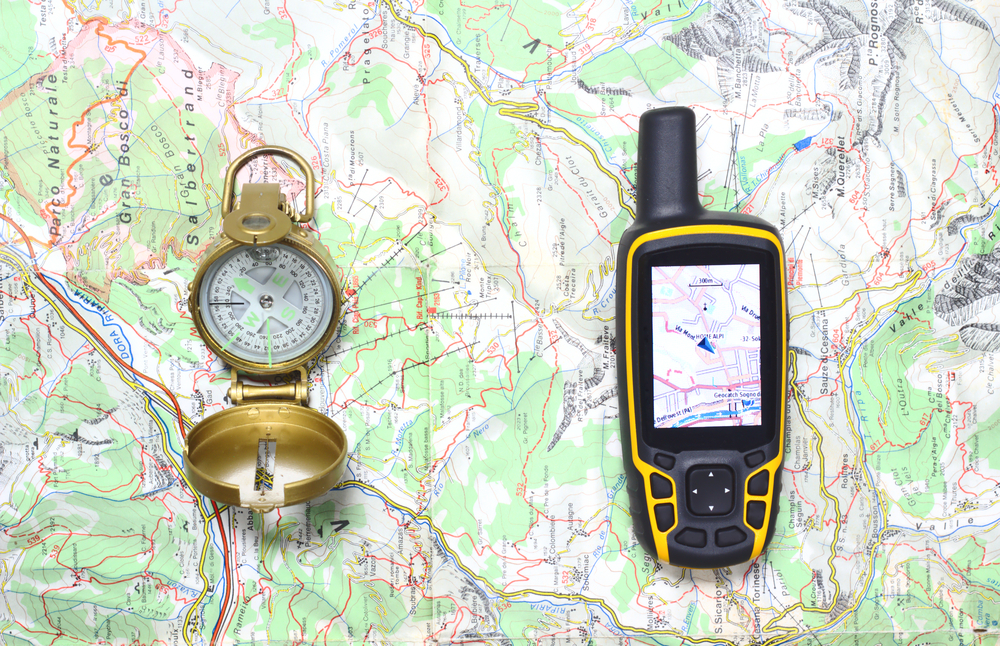
#8 Make Sure Your Day Hiking Gear List Includes Navigation Tools
Most day hikes are on well-marked trails, so it’s easy to think you don’t need navigation tools. Right? That is until you misread the footprints in a fork on the trail and end up somewhere else. So toss in a few essential navigation tools when making your list of what to bring when hiking. Better safe than lost!
✔️ Map – Even for a simple 2-hour day hike, make sure you grab a paper map. Countless times we’ve come to an unmarked fork and had to review a map to ensure we stayed on the correct course.
✔️ GPS – Non-phone-based GPS units are often the best if you do some serious backcountry. But for typical day hikes, plenty of good apps will work with your phone. In most cases, you will need to pre-download maps before heading out, so take a minute to learn to use your app and pull down the maps you might need.
✔️ Compass – A compass only does you good if you know how to use it in conjunction with a map. Take time to learn this simple skill. Most of us feel pretty intimidated by this little machine, but it’s not that hard.
#9 Emergency Overnight Kit
What? This is a day hike why do I need an overnight kit? Well, because 90% of search and rescue is for people who got off the established trail. If that happens to you, you might end up spending the night. What planning what to bring on a day hike, a basic emergency kit is critical.
Even experienced hikers get lost in National Parks by making simple errors. Errors like mistaking a well-used deer path for a hiking trail or going off trail for “just a minute” to see a view and then not finding the original route. Their recommendation:
“All these data points suggest that the best way to survive getting lost in a National Park is to already have the clothing and gear needed for warmth and shelter during the night, as well as some food and water.”
National Geographic
✔️ Makeshift Shelter
A little duct tape, a rain poncho and your hiking poles could quickly turn into a shelter for the night. Those little shiny mylar blankets in most first aid kits work to hold heat. No need to carry the weight of a tent and sleeping bag for a day hike, but do consider what you have in your bag that you could use in an emergency.
✔️ Lighter/Matches
The biggest challenge is to keep them dry, so keep matches in a waterproof bag. Your multi-tool may also have a fire starter tool which makes fires starting a snap!
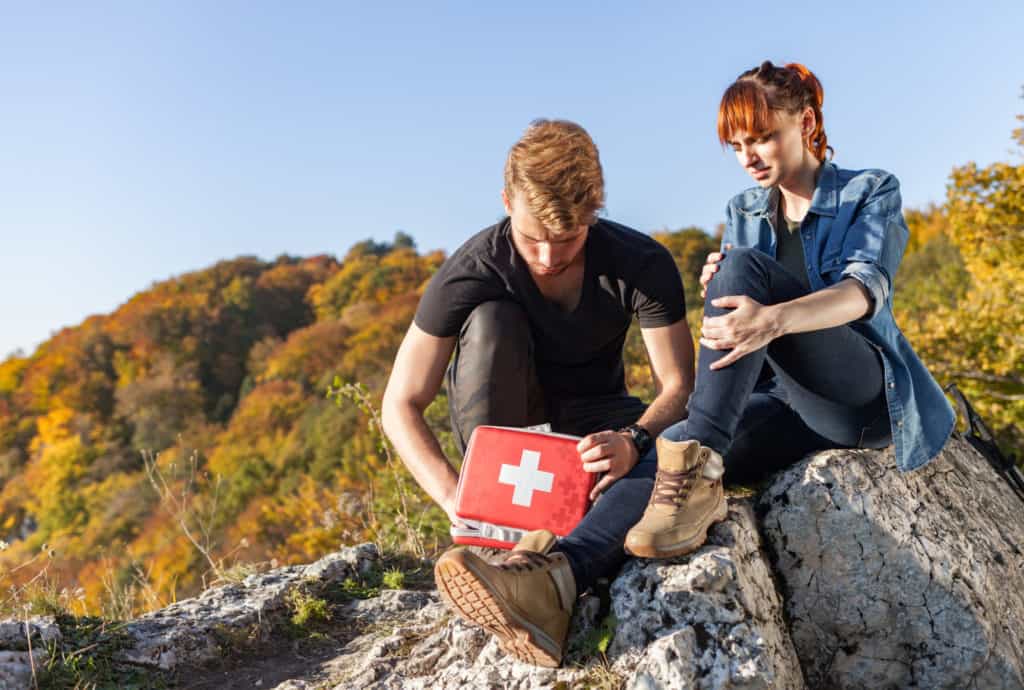
#10 A Simple First Aid Kit Belongs on Your Hiking Essentials List
You can fit most of this into a quart ziplock bag that won’t take up much space in your bag. If it is more than that… you’ll pack too much. You can also find mini first aid kits that will contain small amounts of many of the items you need. It’s a great way to start your personal bag.
✔️ Basic First Aid Medicine and Bandages
Keep it simple when you collect first aid supplies for your day hiking trip packing list. Imagine what’s most likely to happen on the trail. For example, you could easily get cut by a wild tree branch, so hand sanitizer, an alcohol wipe and a couple of band-aids go in your first aid kit. You could get a bee sting, so an antihistamine. Your blood sugar could drop, so a couple of lemon drops. See, you get the idea.
✔️ Ankle/Knee Wrap
After blisters, the most common injury on the trail is a twisted ankle or knee. So popping in a simple ace wrap bandage into your bag will ensure that you have enough ankle support to hobble back to the trailhead.
✔️ Insect Repellent
Even if you aren’t sensitive to bug bites, you will want a small bottle of bug spray. Those wilderness mosquitoes are often meaner and bigger than their city cousins, so you won’t want to be without the bug spray in summer. Bug spray is also important to keep ticks away, so spray around your ankles when walking through tall grass. Here are our tips for repelling mosquitoes away when hiking.
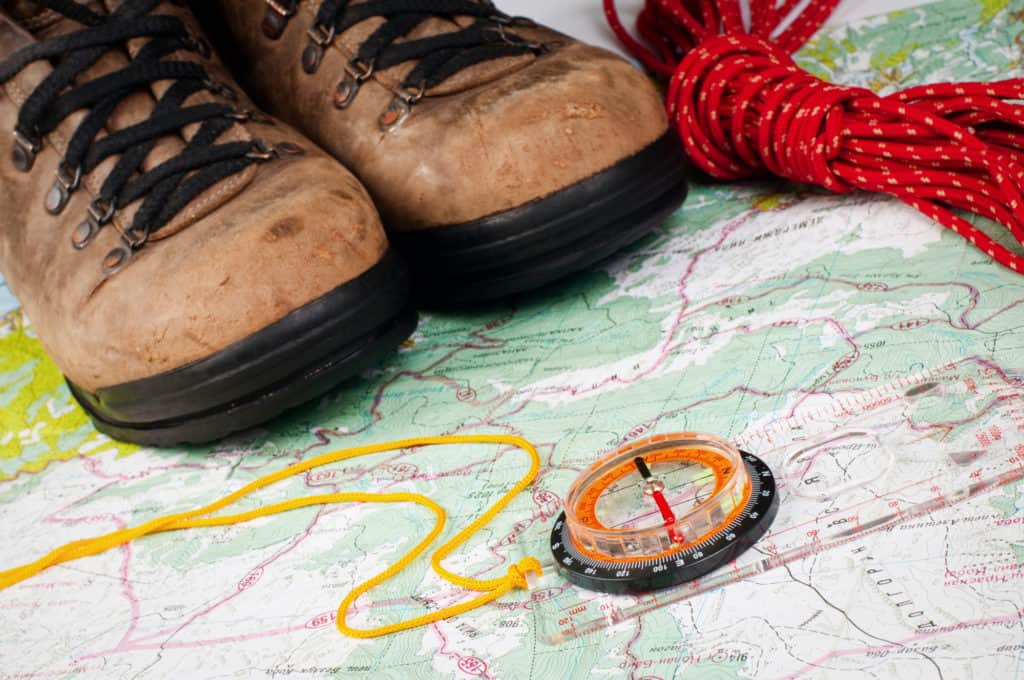
Optional Gear for your Day Hike Checklist
Include in your list of what to bring on a day hike a few extra items that you don’t always thing of…
✔️ Cash/Card/ID – Seems a little silly, doesn’t it, to carry money into the wild. Worst-case scenario, you or a friend needs a rescue, and you will be happy to have that with you. In the best-case scenario, your trail passes through a small town, and you can take a break and grab an ice-cold beverage.
✔️ Fishing License – Well, really only optional if you aren’t planning to fish. We’ve been stopped twice by rangers to check for a fishing license in National Parks and we’ve always had that license ready. (Read one of those close encounters in our article about Rafting Lodore Canyon.) You don’t want to ruin your trip with a huge fine when it’s so easy to go online and get a fishing license before you head out.
✔️ Your Glasses if you Wear Contacts – It’s pretty easy to have dust kick up, and suddenly you are miserable as the grit rolls around in your eyes. Be prepared to take those contacts out at any time.
Capture the Memories
✔️ Camera (or Phone) – This area is defined by your passion! If photography is your thing, then I know you will carry it ALL no matter what we recommend. And you will get those amazing photos that everyone will envy. So worth it!
My rule of thumb is for the rest of us to take a real camera if your hike is less than a 2-hour hike. The weight of the camera won’t be noticeable. For long hikes, save weight and use your phone camera. Today’s phones grab awesome photos and are so much lighter. And we all know that lighter is better, right? Take along a back up charger for your phone if you plan to be out of touch most of the day. That way, you won’t miss a fantastic shot due to a dead phone battery.
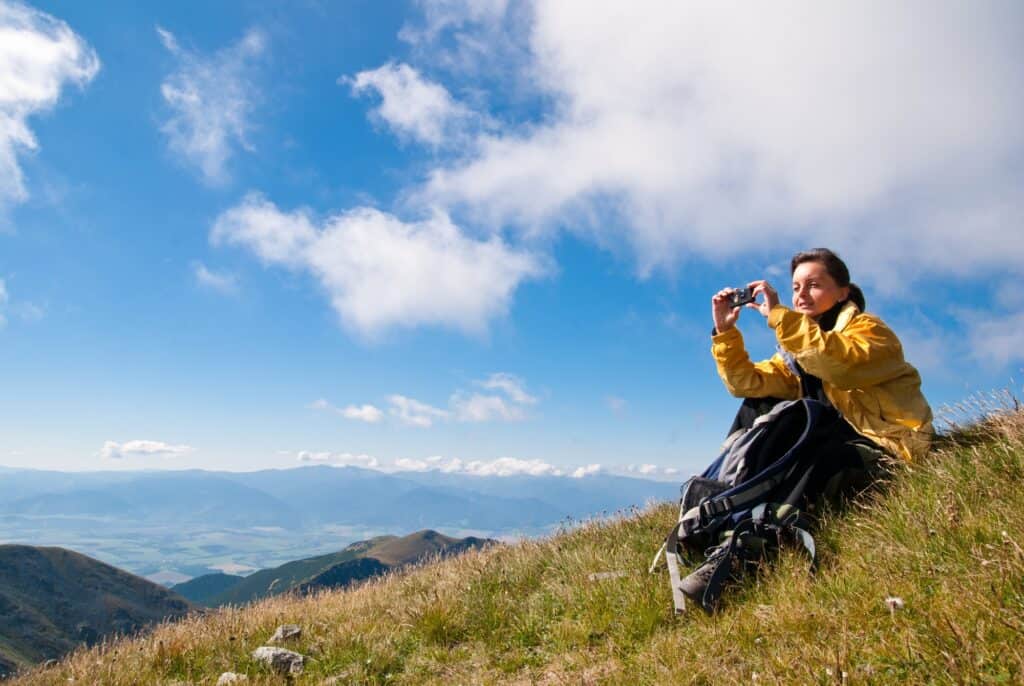
✔️ Binoculars – It’s pretty tempting to leave the binoculars behind to save weight when heading out for a full day. But don’t. I can name a dozen times when we’ve found wildlife on the side of a mountain or in a distant valley that are spectacular when viewed through binoculars.
Consider swapping your old ones out for compact hiking binoculars. You can quickly knock a pound off your pack weight and probably upgrade quality simultaneously.
✔️ Mini Tripod – I love this flexible mini tripod. Human arms just aren’t long enough to grab that amazing mountain in the background. Of course, even though it’s only about 6 ounces (figure ½ can of pop), this could fall on the optional list if your pack is getting heavy.
Seasonal Extras You Need for Day Hikes
Weather is a big factor in deciding what to bring on a day hike. Let’s take a look at those items that change in our pack with the season.
What to Pack for a Day Hike in Cold Weather
✔️ Crampons or Microspikes- If you aren’t familiar with Crampons, they are cleats or chains with a rubber edge that stretches over your boots. These lightweight tools are fantastic for walking on icy roads in your neighborhood and indispensable for winter hiking.
Winter hiking is a pretty broad term as you can find snow and ice on the hiking trails in Glacier and Rocky Mountain National Park into mid-June many years. The best thing about crampons and microspikes is that they can be tucked out of the way in your pack and only pulled out when you hit that icy spot. It just takes a few seconds to stretch them over your hiking boots.
✔️ Extra Gloves – Warm hands, feet and head are the keys to staying warm in cold weather. So you’ll want an extra pair in case your gloves get wet. I like to carry lightweight glove liners year around. We’ve hit some cold days at high altitudes in mid-summer. Then in winter, they make a nice liner under heavier mittens.
✔️ Knit Hat and/or Earband – A knit hat is a great way to regulate your body temperature. Getting hot? Pop off that hat and let some heat escape. Too cold? Put it back on and hold in that heat. The head is the body’s chimney. Now ear bands, also called headbands, are more about keeping the wind and cold off your ears. I find that unless it is bitter cold, I stay warm with just my ears covered and letting that heat from my workout escape.
✔️ Neck Warmer or Gaiter – This is a simple wrap around your neck that you can pull up over your mouth and nose if the wind kicks up. Since it is one loop, think 10-inch wide headband. Around your neck, it is less hassle than a scarf with long tails.
✔️ Leg Gaiter – Leg Gaiters are perfect for keeping your pant legs dry and snow out of your hiking shoes.
✔️ Disposable Hand Warmers – You probably dislike the idea of anything disposable on the trail that could later add to landfills. If you dress appropriately, you will probably never need these. But…BIG BUT… if something happens on the trail in the bitter cold, your first goal is to avoid hypothermia.
So my personal belief is it is worth carrying a few of these in your pack for an actual emergency. Disposable hand warmers are only activated when air exposure, so a set of these could live in your hiking backpack for a long time, ready for that cold weather emergency.
Check out our complete guide to What to Wear When Hiking in Cold Weather for more details on how to plan your winter wardrobe. And also, see our guide to Hiking in Hot Weather for more tips on Summer Hiking.
Hot Weather Backpacking Gear You Will Need
✔️ Cooling Towel – You can find cooling towels in so many fun colors that you might want to get one for yourself. Any towel, or for that matter, a scarf, will work. It’s all about the science of evaporation. When you wrap a wet cloth around your neck or head, evaporation causes you to cool faster. When it’s extremely hot, a cooling towel is a perfect tool to reduce your body temperature.
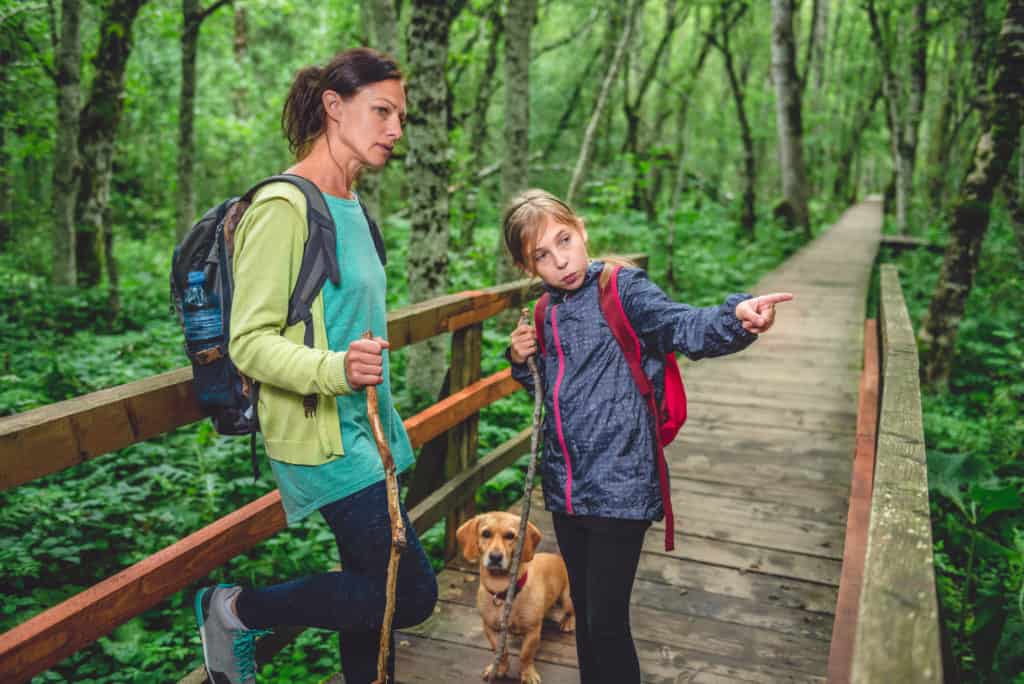
What to Pack for Hiking with Dogs
Wondering what day hiking essentials to pack for a day hike for your dog? Because your 4 legged best friends can’t tell you when they are exhausted or overheated, proper packing for their needs is critical. You’ll also find our tips for hiking with a puppy here.
✔️ Leash and Collar – Even on trails that allow dogs off-leash, you should carry one. You never know when you will encounter a frightened child or skittish fellow trail dog.
We recommend that you pick up one that lights up in the dark just in case you are late getting back. Or heaven forbid, your best friend bolts off after a rabbit, and you are trying to find him in the dark. We dug into the best LED reflective gear for hiking dogs – check out our finds.
✔️ Water Bowl – And of course, extra water. Consider a collapsible dog water bowl to save space in your bag.
✔️ Food and Treats – Your baby will be burning a lot of energy on the trail. Make sure you have food so he can replenish it.
✔️ Poop Bags – Just like everywhere else, you need to be prepared to pack it out.
✔️ Doggie Backpack – Seriously, consider letting your dog carry some of their own gear. Cesar Millan suggests a dog can carry 10-12% of its weight if you start light and work your way up. He also recommends checking with your vet first before starting with a doggie backpack.
Remember that, like with you, carrying weight will make the hike more of a workout for your dog, so plan appropriate rest.
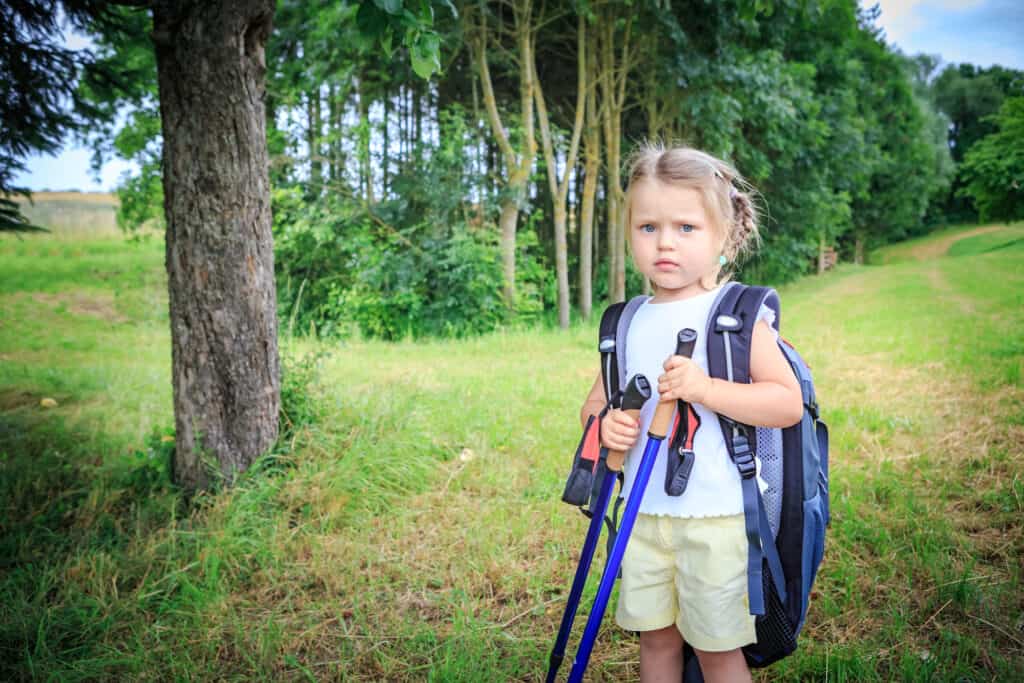
Must Have Hiking Gear for Kids
Kids exploring nature are so much fun. They are inspired by the wonder of discovering the world’s largest slug or figuring out what critter made those prints in the mud. You’ll find more tips for hiking with kids here.
At the same time, teaching your child a bit of responsibility during the hike is also important. They should carry a light pack with their sweatshirt, water, and maybe a few snacks. Here are a couple of special things you might want to take along.
✔️ Water Shoes and Extra Socks – Water is like a magnet to children. So just assume it will happen and plan for wet feet. These Crocs River Sandals are perfect. I know it adds some bulk to your pack, but nothing is worse on the trail than an unhappy child. And wet socks in wet hiking boots are the key to painful blisters. In fact, an extra pair of hiking pants and a shirt is usually a good idea. While we are talking about water, don’t forget a rain jacket for the kids!
✔️ Binocular of their own – Kids love binoculars. So rather than having them change your settings, which can be very annoying, just give them compact binoculars of their own.
✔️ Flashlight – Go for a super lightweight flashlight. Check out our guide on how to select the perfect flashlight for kids.
✔️ Clip-on Stuffed animals or toys – Kids often love a photo with their favorite toy in unique places, or if exhaustion kicks in, a toy can be comforting.
✔️ Whistle – This might be the most critical item to have on your day hiking gear list when traveling with kids. Teach your child how to use the emergency whistle if they suddenly find themselves separated from you.
Whew… that’s a long hiking essentials list. Right? I can’t emphasize enough how important it is in planning what to pack for a day hike that you personalize this list for your style and the type of hike. There are many items you will want to carry beyond the ten essentials. Hopefully, you have found enough information in this detailed day hiking packing list to help you make an informed decision.
